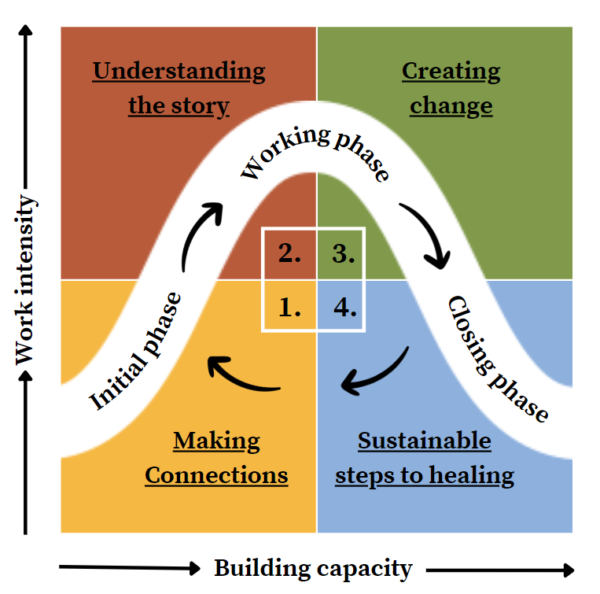This is the Narrative Practice Pathway. It has been developed by our team and provides guidance on the steps we can take to engage in a compassionate and solution-focused approach to doing counselling and community work.

This page includes resources that may help you in working with individual clients and families, as well as responding to bigger social and community concerns and problems.
1. Making connections
Dadirri (inner deep listening and quiet still awareness) – The word, concept and spiritual practice that is dadirri (da-did-ee) is from the Ngan’gikurunggurr and Ngen’giwumirri languages of the Aboriginal peoples of the Daly River region (Northern Territory, Australia). Read a reflection and watch a video on this practice by Miriam-Rose Ungunmerr.
Social yarning – This article ‘yarn with me’ talks about a simple, person-centered framework for health practitioners to communicate with Aboriginal patients. Social yarning is the first element – a way to develop relationship, find common ground and share life experiences.
2. Understanding the story
SEWB wheel informal assessment – The SEWB wheel describes the holistic nature of Aboriginal and Torres Strait Islander people’s wellbeing. The SEWB wheel can be used as a tool for conducting an informal assessment of what is going on for a person.
Tree of Life Exercise – This exercise supports people to tell the story of who they are. It draws out information about history, values, hopes, support networks and things you want to let go of. It can be adapted based on your context.
A framework for receiving and documenting testimonies of trauma – This paper was developed by David Denborough. It provides a framework for receiving and documenting stories from people who have been subjected to trauma, violence and abuse. It is designed to document stories in ways that are not re-traumatising and that can contribute to redressing the effects of trauma in a person’s life.
3. Creating Change
What gets us through hard times. -This exercise is about building a better understanding of our strengths. We do this by talking about a particular value, belief, skill, or knowledge that gets us through hard times and exploring where this comes from and what it says about us.
The role of innovative moments in the construction of change. – This article talks about the way that narrative practitioners can make use of people’s “unique moments” to build change in the stories we have about ourselves.
4. Sustainable Steps to Healing
Re-membering reciprocal relationships – This video from the Dulwich Centre explores stories of work with Aboriginal people in Murray Bridge, a rural town in South Australia. You can read more about this work here.
Using therapeutic documents – This paper by Hugh Fox describes four different categories of document – letters recording a session, documents of knowledge and affirmation, news documents, and documents to contribute to rites of passage. Documents don’t have to be written down, they could be in the form of songs, artwork or other creative practices
